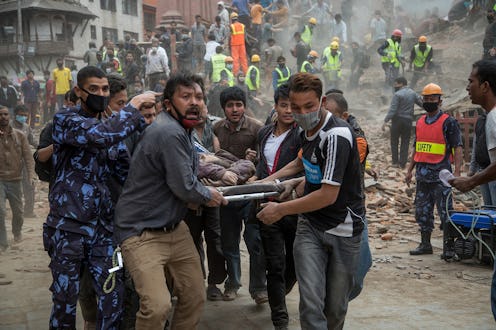News
Did The 1st Nepal Earthquake Cause The 2nd One?
Just two weeks after a devastating quake killed more than 8,000 people in the country, another earthquake struck Nepal on Tuesday. The latest earthquake hit near the town of Namche Bazaar and Mount Everest and created a familiar frantic scene in the capital city of Kathmandu. Because of its location, China's state-run Xinhua news agency reported that the earthquake also affected residents in Tibet and northeastern India. Sixty-eight people have been confirmed dead so far, while more than 1,200 people have been reported injured. As emergency workers continue to look for survivors, officials don't have to dig too deep for the cause — Tuesday's quake was directly related to the massive one on April 25.
In comparison to the earthquake in April, which measured at 7.8, struck the village of Barpak in the Gorkha district, and hit at a depth of approximately 9.3 miles, the latest quake's epicenter was near the Chinese border between Kathmandu and Mount Everest and it also hit at a depth of 9.3 miles. The most significant difference is that the one in April was more than three times bigger and 5.6 times stronger than Tuesday's quake, according to the U.S. Geological Survey (USGS).
If two major earthquakes in two weeks seems like a cruel coincidence, it might be a small consolation to know that science played a part. In fact, Tuesday's earthquake was a direct result of the April 25th tremor. According to the USGS, the second earthquake was an aftershock of the first and the organization had actually estimated that it would hit sometimes this week.
Aftershocks are earthquakes that happen after a large earthquake, known as the mainshock, striking the same general area in the days and even years following. While aftershocks are often insignificant and some are not even felt, some can do additional damage, especially in areas made vulnerable by the original earthquake, such as the case in Nepal.
A May 8 press release on the USGS site reads:
The aftershocks are a normal occurrence after large earthquakes, and are expected to continue in Nepal but occur less often with time. ... For the week of May 8 to May 14, the USGS estimates that aftershocks will continue, but at a decreased rate. The chance of a magnitude 5 to 6 aftershock is about 1-in-3 or 37 percent and 2 or fewer such events are expected.
The estimate likelihood of a magnitude 6 or 7 earthquake was even less with a 5 percent of 1-in-20 chance, and a 7 to 7.8 quake nearly impossible with a 1-in-200 chance, the USGS estimated. That equals a 99 percent chance that a magnitude 7 earthquake would not occur between May 8 and 14, which means that Tuesday's quake beat incredible odds to happen.
If there is a lesson to be learned here, it's that earthquake-affected regions should always be prepared for the possibility of aftershocks, even if the estimated likelihood is low.
Images: Getty Images (2)
